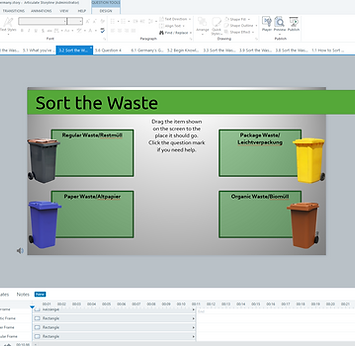Project Overview
Sorting waste in Germany can be quite a challenge. With eight different types of waste, newcomers to the country often feel overwhelmed with learning the systems and the vocabulary associated with them. This eLearning course helps users learn about the different types of waste, determine how to sort the waste properly, and discover the vocabulary associated with each type of waste. The course is sponsored by an imagined waste management company, Grüner Kreislauf, and includes terminology reflective of the types of waste found in the German state of Lower Saxony (Niedersachsen).
Audience
People who are new residents in Germany that need to learn about its waste system
responsibilities
Instructional design
eLearning development
Graphic design
Storyboard development
Tools Used
Articulate Storyboard 360
Canva
Design Process

Next, I developed a storyboard to clearly indicate what the user experience would be like for this course. Taking a slide by slide approach, I described all of the things the user would encounter: text, visuals, interactive activities and dialogue for an avatar named Zoe.
Originally, Zoe was not planned as part of the course, but including her and assigning her a role as a waste management expert with the company added credibility to the course, as well as a sense of comfort for the user. The voice heard throughout the course is my own, including the German translations, and the users reported that the positive and encouraging tone in the audio motivated them while they were learning.
When it was time to develop the prototype, it was clear that the level of interactivity required for this course would be best developed in Articulate Storyline 360. This process involved inputting, programming, testing, and redesigning.
After gathering feedback from instructional designers and users (actual newcomers to Germany who were experiencing this challenge), I made several adjustments, including the addition of Zoe, more varied interactive activities, and a knowledge check at the end of the course


Additionally, because of the complexity and specificity of the images required for the interactions, I use Canva to create custom images and components. It also became apparent early on in the process that a logo needed to be developed to give credibility to the project, and the custom Grüner Kreislauf logo was also created in Canva.
Full Development
The final eLearning experience for “Creating a Positive Remote Working Environment” is sharp and easy to navigate. Its interactive components encourage the user to engage in their learning in a simple, yet reflective, way. One of the best things about this course is that its potential reach is quite large; with so many companies implementing hybrid or fully remote work environments, it would be easy for this course to be further customized to a company’s individual needs and challenges. This type of course is also really important because a company that requires its employees to participate in a course like this one demonstrates empathy for the well-being of employees, a trait that is of the utmost importance in today’s increasingly digital world.
Finally, the “How to Sort Waste in Germany” course was ready to be experienced by newcomers to Germany. The course includes a variety of interactive components and repeated exposure to concepts in order to achieve the learning goals. Although the company Grüner Kreislauf is not real, the branding throughout the course and on the customized menu exposes potential customers to the company as a waste management provider, thereby offering brand exposure and building consumer trust. If this course were to be offered by an existing company, there would be many opportunities to gain new customers throughout the course, including information to contact a representative or learn more about their waste management offerings.
Results and Takeaways
The users of this course were very satisfied with the interactivity and knowledge they acquired through this project. They reported that the sequencing was clear, the activities were engaging, and that the repetition was just the right amount to help solidify their understanding. Additionally, having Zoe as a guide throughout the course built a personal connection for them and made them feel they could trust what they were learning, as she appeared and sounded very warm and approachable.
I learned many things during this project, and the feedback I received from other instructional designers was invaluable. With their feedback, I was able to create clearer, more functional activities. I also appreciated some of their suggestions that helped me develop better triggers and user instructions.
At the end of this project, I felt much more comfortable using Articulate Storyline than I had when working on simpler projects. I also became more aware of the program‘s limitations, which pushed me to create stronger, more appropriate design elements outside of the authoring tool.
This project was really enjoyable, especially since I was once a newcomer to Germany and could really have benefited from a course like this. It gave me confidence to continue working on highly interactive eLearning experiences, and I could see this course being developed into even more in-depth courses in the future.


